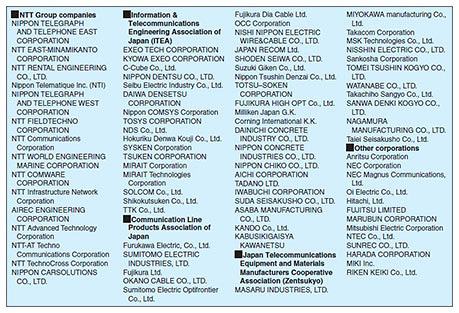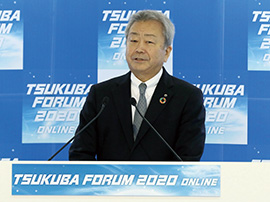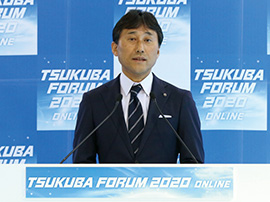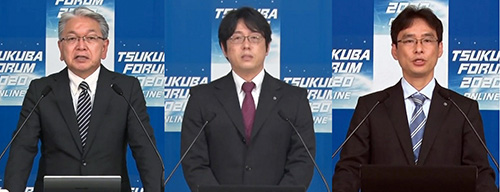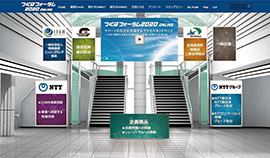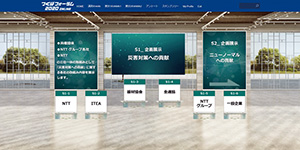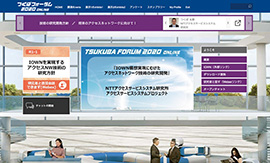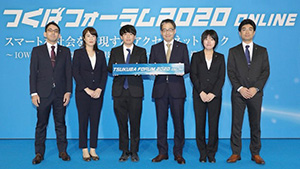 |
|||||||||||
|
|
|||||||||||
|
Information Vol. 19, No. 4, pp. 63–69, Apr. 2021. https://doi.org/10.53829/ntr202104in1 Event Report: Tsukuba Forum 2020 ONLINEAbstractTsukuba Forum 2020 ONLINE was held on October 29 and 30. To prevent the spread of COVID-19, the event was not held at the NTT Tsukuba R&D Center (Tsukuba City, Ibaraki Prefecture) as in previous years but online. The theme of the forum was °»Supporting the smart world°ĹInnovative technologies for the IOWN [Innovative Optical and Wireless Network] concept and advanced technologies for business growth.°… This article gives a brief overview of the speeches and exhibits presented at the forum. Keywords: Tsukuba Forum, access networks, IOWN 1. IntroductionThe theme of Tsukuba Forum 2020 ONLINE was “Supporting the smart world—Innovative technologies for the IOWN [Innovative Optical and Wireless Network] concept and advanced technologies for business growth.” It was held with the intention of further developing access network technologies that support people and companies in response to changes in society, which has seen dramatic transformations of working styles and lifestyles. In addition to NTT Access Network Service Systems Laboratories (AS Labs), 85 organizations, including co-hosting organizations and NTT Group companies (Table 1), participated. They introduced and exhibited the latest research and development (R&D) and technological trends.
2. Overview of speechesThe two keynote speeches were streamed live on the first day. 2.1 Keynote speech 1Jun Sawada, president, chief executive officer, and representative member of the Board of NTT, gave a speech titled “NTT Group’s Initiatives for a Post-COVID-19 Society” (Photo 1). For details, see that article in this issue [1].
2.2 Keynote speech 2Ichiro Uehara, senior executive vice president of NTT WEST, gave a speech titled “Toward the Realization of Smart Regional Societies, ‘To Be the Social ICT Pioneer’” (Photo 2). For details, see that article in this issue [2].
The results from questionnaires revealed that 99% of audience members gave the comments that the speeches were “helpful” and “deepened my understanding of NTT’s efforts.” Because these speeches were streamed online, the venue and audience size were not restricted and were available on-demand for one month, four times as many people as in previous years viewed the speeches. 3. WorkshopsWorkshops were streamed on-demand beginning at 9 a.m. on the first day of Tsukuba Forum 2020 ONLINE and accessible for one month. An executive manager of NTT Infrastructure Network Corporation and two project managers from AS Labs conducted the workshops (Photo 3).
3.1 Workshop 1Yoichiro Takaki, executive manager of the Smart Infra Promotion Department, NTT Infrastructure Network Corporation, gave a lecture titled “Activities Centered Around the Smart Infrastructure Platform.” For details, see that article in this issue [3]. 3.2 Workshop 2Kazunori Katayama, project manager of the Access Network Media Project, AS Labs, gave a lecture titled “R&D of Innovative Optical Transmission Line Technologies.” For details, see that article in this issue [4]. 3.3 Workshop 3Tomoaki Yoshida, project manager of the Optical Access Systems Project, AS Labs, gave a lecture titled “Photonic Gateway and Related Optical Access Technologies to Achieve the All-Photonics Network.” For details, see that article in this issue [5]. 4. Panel discussionsCo-hosting organizations, NTT Group companies, and the NTT laboratories united to introduce efforts and hold panel discussions on two themes: “Prospects for Space Satellite Utilization” and “Smart Access Technology.” The panelists introduced examples from different companies. Their discussions were live-streamed. 4.1 Panel discussion 1For the theme of “Prospects for Space Satellite Utilization,” Fumihiro Yamashita, group leader of the Wireless Entrance Systems Project, AS Labs, served as facilitator. Members of the Japan Aerospace Exploration Agency (JAXA) and SKY Perfect JSAT Corporation joined the panel with members of the NTT Group and discussed the topic of “Expectations and challenges for space and satellite utilization in daily life.” In the first part of the panel discussion, Mr. Yamashita introduced the current state of space satellite technology, and the panelists, all involved in the field of space satellites, expressed their views on why space satellite applications will increase going forward. In the second part, NTT DOCOMO, NTT EAST, and NTT Communications introduced examples of their current space satellite utilization efforts, challenges, and future expectations and exchanged views on issues when engaging in new space business. In the third part, JAXA and NTT laboratories introduced their space satellite R&D. They discussed the areas of R&D, national policy, and company measures needed for Japan to develop and lead the space satellite business and utilization by 2030 (Photo 4).
4.2 Panel discussion 2For the theme of “Smart Access Technology,” Takashi Ebine, project manager of the Access Network Management Project, AS Labs, served as facilitator. Members of NTT EAST and telecommunication construction companies took the stage and discussed the topic of “Smart access toward automated construction and remote control with robotics.” In the first part of the panel discussion, Mr. Ebine introduced the background and direction of efforts in the area of smart access technology. Topics included changes in the business environment of the telecommunication construction industry, trends in improving outside-plant work efficiency, technologies for smart outside-facility management, and future directions in the development of aerial structure construction. The panel members exchanged fresh viewpoints on the challenges of automated construction involving remotely controlled heavy machinery. They also discussed factors hindering efficiency such as how to deal with metal facilities going forward. In the second part of the session, the panelists discussed the need to review building materials and construction methods. They also presented a video that showed excavation using a power shovel controlled in virtual space as an example of efforts to automate construction. The panelists also discussed work using remote control in the IOWN era, which, together with major technological advances such as artificial intelligence (AI) and Internet of Things (IoT), will drastically transform conventional work methods. Finally, members from AS Labs voiced their desire to work closely with partners in the field and strongly support them into the future (Photo 5). During the livestreaming of the panel discussions, online audience members could send questions to panel members. Many participants gave the comment that they found this program meaningful.
5. Overview of exhibitsIn addition to exhibits from AS Labs, exhibits on the network access technologies by the co-hosting organizations and NTT Group companies were held (Photo 6). A total of about 150 exhibits were presented with videos and slides to introduce each organization’s products and efforts. During the two days of the forum, staff members from the respective organizations virtually stood by their booths and responded to online visitors with direct chat, messages, and video conferencing.
5.1 Special exhibitionsCo-hosting organizations, NTT Group companies, and NTT laboratories united to introduce their efforts on the themes of “Contributing to disaster countermeasures” and “Contributing to the new normal.” The results from questionnaires revealed that 96% of online visitors gave the comments that the exhibits were “helpful” or “very helpful.” Visitors also commented that the exhibits on disaster countermeasures helped them understand how the organizations were leveraging past experiences to tackle challenges and that they found the materials extremely helpful. Concerning the theme of “Contributing to the new normal,” visitors’ comments included “I would like to try the technologies exhibited by NTT laboratories in my own company” (Photo 7).
5.2 NTT exhibitsIn virtual exhibition halls, NTT presented its R&D achievements in the area of “Innovative technologies to achieve the IOWN concept” and “Advanced technologies to contribute to enterprises” (Fig. 1). These access network technologies promise to bring about a smart society. Visitors to the exhibits were able to directly converse with researchers via web conferencing (Webex), deepening their understanding (Photo 8).
(1) Innovative technologies to achieve the IOWN concept The exhibition introduced innovative access network technologies such as space-division multiplexing optical fiber and transmission technologies, photonic gateway technologies, and Cradio® multi-wireless proactive control technologies. Visitors were able to talk directly with researchers using Webex at the following virtual exhibits: 1) Research and development toward future access networks for achieving IOWN, 2) Remote beamforming technology for analog RoF [radio-over-fiber] systems, 3) NW [network] resource management technology (NOIM [Network Operation Injected Model]) that unifies the management of various components of the IOWN APN [All-Photonics Network], 4) Optical fiber environmental monitoring technology using communication networks, 5) Multi-core optical fiber and cable technologies for supporting all-photonics networks, 6) Protocol-free management and control in All-Photonics Network, 7) Distributed antenna systems using higher frequency bands for ultra-high capacity and ultra-high speed in wireless access systems, 8) MIMO [multiple-input multiple-output] satellite systems and a global sensor network using LEO [low-Earth orbit] satellites, 9) FM [frequency modulation] conversion technology for protocol-free transmission, 10) Dynamic radio control—a component of Cradio® (multi-radio proactive control technology), 11) Intelligent radio-wave design, 12) Intelligent radio-wave design: virtual massive MIMO transmission, 13) Intelligent radio-wave design: radio-quality platform, 14) Intelligent radio-wave design: wireless sensing, 15) AI for wireless network design by estimating radio wave propagation, 16) Fast handover control technique by millimeter-wave positioning detection providing gigabit wireless transmission, 17) Single carrier MIMO technology for high speed toward super high frequency bands, 18) Centralized quality control independent of wireless networks, and 19) Connection pattern optimization between multi-networks and multi-terminals. (2) Advanced technologies to contribute to enterprises Presented in this exhibit were advanced technologies that transform enterprise tasks and onsite work, such as operation and maintenance automation technologies, contributing to solving social problems. Visitors could talk directly with researchers using Webex at the following virtual exhibits: 1) Management technique for stable operation of IEEE 802.11ah system, wireless LAN [local area networks] for IoT, 2) VHF [very-high- frequency] band digital radio subscriber system (TZ-68D), 3) Verification of bow-shaped guy wire for long-term safe use of outside facilities, 4) ICT [information and communication technology] conversion of Cable Tunnel Management System, 5) Inspection technology for deep underground manholes using automatic flying drones, 6) Work-allocation technology that can reproduce finest human judgment, and 7) Inter-system coordination using UI [user interface] augmentation technology. 5.3 Information & Telecommunications Engineering Association of Japan (ITEA)This exhibition presented ITEA’s efforts to develop secure, safe, and reliable information communication infrastructure facilities. These efforts include transmitting from one generation to the next the technologies and expertise that its member companies have developed, improving the quality and efficiency of these technologies and promptly restoring facilities in the event of a major disaster. 5.4 Communication Line Products Association of JapanExhibits ranging from those benefiting onsite workers to products related to IOWN were presented in three virtual halls: “Forefront of Communication Cables,” “Latest Trends in Connection Technologies,” and “Lineup of Aerial-related Technologies.” 5.5 Japan Telecommunications Equipment and Materials Manufacturers Cooperative Association (Zentsukyo)Under the slogan, “Zentsukyo, taking on the challenge of creating dependable technologies and products through DX [digital transformation],” the exhibits introduced efforts in the advancement of DX by developing products with each member company’s outstanding technical capabilities and demonstrating collective strength through synergy that comes from uniting as one. 5.6 NTT GroupThe exhibition introduced the NTT Group companies’ latest technologies to further advance DX and contribute to solving social problems. 5.7 Other online functionsOver the two days of the online forum, an interaction plaza was provided as an open chat space where all registered participants could freely post comments. In addition, visitors used “vCard” functionality as virtual business cards on the Tsukuba Forum 2020 ONLINE website to communicate with one another and deepen exchanges. The digital stamp rally, which had been very well received in previous years, was held again. Participants received stamps with points when they fulfilled conditions such as attending keynote speeches and visiting exhibit booths. Those who gained 3000 points or more were eligible for a drawing to receive novelty items. 6. ConclusionThis was the first time Tsukuba Forum was held online. About 9000 people registered, the most ever. While there were challenges such as not being able to view demonstration or touch exhibits and not being able to quickly obtain the responses of participants, and some participants expressed their desire for the forum to be held physically, the event was highly evaluated as it allowed participants to view exhibitions and listen to speeches at their own leisure without restrictions on location and capacity. Compared with previous years, four times as many visitors listened to the keynote speeches and three times as many people attended the panel discussions. The forum ended with high praise from numerous participants. 93% of the attendees replied that they could feel the urgency of the themes of Tsukuba Forum 2020 ONLINE, and many voiced the opinion that they found the IOWN exhibits useful and could feel hope for the future. Through the online exhibitions of innovative technologies to achieve IOWN and advanced technologies to solve social problems and contribute to business, Tsukuba Forum 2020 ONLINE became a more valuable place than ever before for sharing information. AcknowledgmentsWe thank the Information & Telecommunications Engineering Association of Japan, the Communication Line Products Association of Japan, and the Japan Telecommunications Equipment and Materials Manufacturers Cooperative Association (Zentsukyo) for their support of Tsukuba Forum 2020 ONLINE. References
|
|||||||||||

